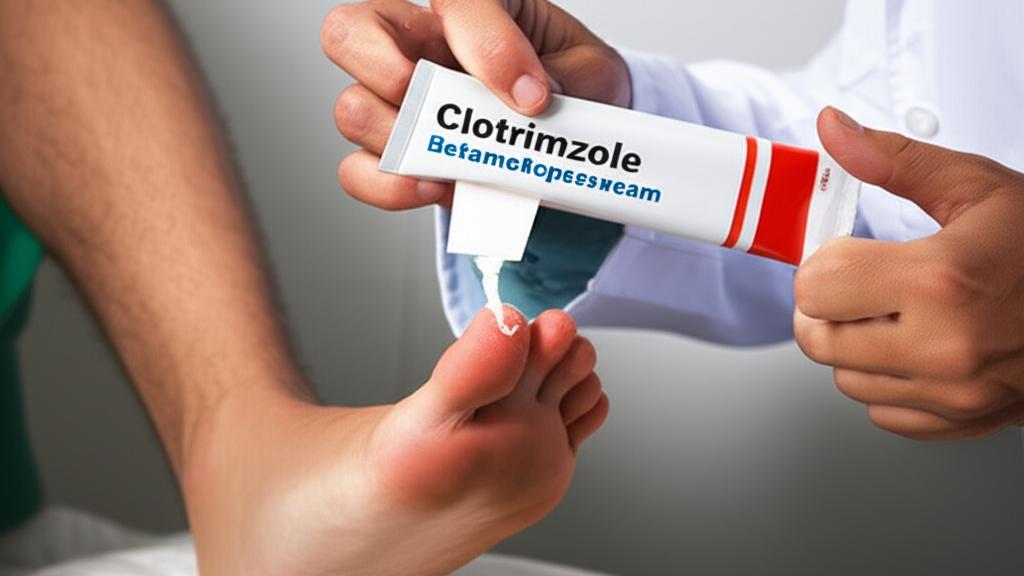I see it all the time in my clinic. Someone comes in, frustrated and just plain uncomfortable, with an itchy, red rash that just won’t quit. Maybe it’s between the toes—what we call athlete’s foot—or in the groin area, known as jock itch. They’ve tried over-the-counter creams, powders, you name it. When that happens, and we confirm it’s a stubborn fungal infection with a lot of inflammation, we often need something a bit stronger. That’s where a prescription cream like Clotrimazole Betamethasone can be a real game-changer.
What Exactly Is Clotrimazole Betamethasone Cream?
Think of this medication as a two-in-one powerhouse. It’s a combination cream, often known by the brand name Lotrisone, that brings together two different medicines to do two different jobs.
- Clotrimazole: This is the antifungal part. Its job is to directly fight and kill the fungus causing the infection, like ringworm, athlete’s foot, or jock itch.
- Betamethasone: This is a corticosteroid—a mild steroid. It doesn’t kill the fungus, but it works wonders on the symptoms. It calms down that angry swelling, redness, and itching that makes these rashes so miserable.
Together, they tackle both the cause and the discomfort. It’s a prescription medication, so you’ll need to see a healthcare provider to get it.
How to Use This Cream Correctly
Using this cream the right way is key to getting better. It’s for your skin only—never take it by mouth.
First, always wash your hands before and after you apply it. You only need a thin layer—just enough to cover the affected skin. Rub it in gently. It’s important not to cover the area with a tight, air-blocking bandage (like a plastic one) unless your doctor specifically tells you to.
You have to use it for the full time we prescribe, even if the rash starts looking better after a few days. Fungal infections can be sneaky and come right back if you stop treatment too soon.
A really important point: Please, do not use this cream to treat diaper rash. The steroid in it can be too strong for a baby’s sensitive skin in that area and can cause problems.
A few extra tips that really help:
- For ‘Jock Itch’: After you shower, make sure the groin area is completely dry. Wear loose-fitting, cotton underwear. Avoid tight synthetics like nylon that trap moisture.
- For Athlete’s Foot: Dry your feet very carefully after bathing, especially between your toes. Wear clean cotton socks and change them daily, or more often if your feet get sweaty.
Before You Start: A Quick Chat With Your Doctor
Before I write a prescription for this, there are a few things I need to know to make sure it’s safe for you. Be sure to tell your care team if you have:
- Any history of an allergic reaction to clotrimazole, betamethasone, or other medications.
- Large areas of burned or damaged skin.
- Any issues with skin thinning.
- Poor circulation or peripheral vascular disease.
- If you are pregnant, trying to get pregnant, or breastfeeding.
We also need a full list of your other medicines, herbs, or supplements, just to be safe. The main topical medication we watch for an interaction with is one called nystatin.
Potential Side Effects and When to Call Me
Most people do just fine with this cream, but like any medicine, it can have side effects. We can break them down into two groups: things you should call me about right away, and things that are more common but usually not serious.
| Side Effect Guide | |
|---|---|
| Call your doctor or seek help if you experience: | |
| |
| Less urgent side effects (but let us know if they continue): | |
|
If your symptoms don’t start getting better within a week (for jock itch) or two weeks (for athlete’s foot), give us a call. We need to reassess what’s going on.
Take-Home Message
- Clotrimazole Betamethasone is a prescription cream that combines an antifungal to kill the infection and a steroid to calm itching and redness.
- Use only a thin layer on the affected skin, and complete the entire course of treatment.
- It is NOT for treating diaper rash.
- Keep the area clean and dry, and wear breathable, cotton fabrics to help the healing process.
- Call your doctor if the rash isn’t improving or if you notice serious side effects like skin thinning or signs of an allergic reaction.
Skin issues can be incredibly frustrating, I know. But you’re not alone in this, and with the right approach, we can get it cleared up. We’ll get through this together.


